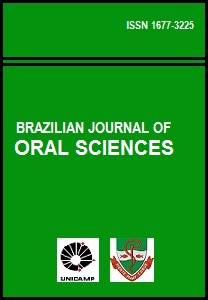Abstract
Aim: The objectives of this study were to evaluate the levels of glucose, cholesterol, protein and albumin in saliva, and to correlate the levels of glucose of the saliva to oral health and blood glucose of diabetic and non-diabetic children. Methods: 32 children with type 1 diabetes mellitus formed the study group (DC) and 32 non-diabetic children formed the control group (ND). The patients had their saliva collected and evaluated for glucose, cholesterol, total protein and albumin. Blood glucose analysis was also performed. The dental health status of the subjects was measured by DMFT index and def index. Independent Student’s t-test was performed to compare metabolic status values in DC and ND groups. Correlation test was applied between blood glucose and salivary glucose (Spearman’s correlation), and salivary glucose and DMFT/def (Spearman’s test). Results: A statistically significant difference was observed between DC and ND considering salivary glucose (p=0.000). Elevated levels of cholesterol were evident in DC in correlation with ND. Total protein and albumin had increased values in DC (nonsignificant p value). The dental health status was not statistically different. Conclusions: Salivary parameters can act as adjuncts in assessing the overall metabolic status of the patient.The Brazilian Journal of Oral Sciences uses the Creative Commons license (CC), thus preserving the integrity of the articles in an open access environment.
Downloads
Download data is not yet available.

